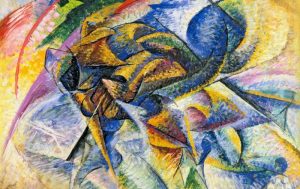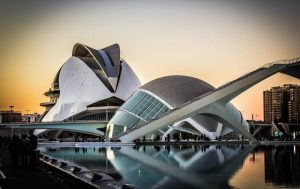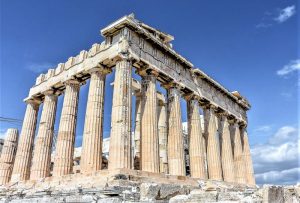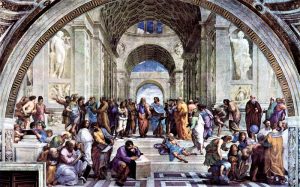Futurism
Futurism was an artistic movement that was born in Italy in the twentieth century and managed to expand throughout Europe. It was launched by the Italian poet Filippo Tommaso Marinetti through his publication in the Figaro newspaper of France in 1909 through his Futurist Manifesto.
What is Futurism?
Futurism was an artistic and literary movement that focused on breaking the past of art and literature to express its idea that art was something fluid and that it was always in motion through manifestos.
About Futurism
Futurism consisted of an avant-garde movement that attempted to reflect movement, dynamism, speed, the inner strength of things, war exaltation, machines and all things that the authors considered to be modern. It was a movement that ended the traditional, the past and academicism.
Characteristics
The main characteristics of Futurism are:
- It used vibrant techniques with color compositions.
- Divisionism and abstraction
- Objects were dematerialized, a situation that came from Cubism.
- There was the multiplication of positions of the same element.
- There was a marked intensification of action by means of repetition.
- It tried to capture the sensation of movement.
Origin
Futurism originated in Milan, Italy, driven by Filippo Tommaso Marinetti. It comes from Cubism and was basically an Italian movement.
History
The movement was born in Milan, Italy, and was initiated by Filippo Tommaso Marinetti, on February 20, 1909. It was made to eliminate tradition, the past and conventional signs that the art believed were the main elements. The motto of the first futuristic manifesto was “Freedom for Words“.
Futurism comes directly from Cubism, however, they managed to evolve rapidly towards a differentiated aesthetic, due to their obsession with representing speed. This was an Italian birth movement. It was the first movement to organize itself as such, and it did so through the Futurist Manifesto, published by the poet Filippo Tommaso Marinetti.
Futurism in sculpture
The sculpture manifesto established the direction of futuristic sculpture and visual arts. Its aim was to inaugurate a time of tradition and celebrate change, originality and innovation in culture and society. The manifesto exalted the beauty of the machine and the new technology of the automobile, its speed, power and movement.
Literary Futurism
In the literary field, Futurism emerged in Italy in the first ten years of the 20th century. It revolved around Filippo Tommaso Marinetti, who published the Futurist Manifesto in the Parisian newspaper Le Figaro on 20 February 1909.
In this type of literature there was an exaltation of original things, of the structures of movement such as time, speed and energy, and there is a rupture in the tradition of literature, the past and the conventional signs of art.
Musical Futurism
Musical Futurism was linked to literary and pictorial creation. Its most important representatives were Filippo Tommaso Marinetti and Francesco Balilla Pratella, an Italian musician who was the author of the Futurist Musicians Manifesto. Albert Montserrat stated that vanguards musicians and classics were far from futuristic music as aesthetics. To him, musical work had to be dominated by the machine and by electricity.
The use of noise was promoted by the painter Luigi Russolo who in his Manifesto of the Noises states that music would be influenced by Marinetti’s poetry. Russolo, grouped the noises in his investigations.
Italian Futurism
Italian Futurism was the movement that laid the foundation for Benito Mussolini’s fascism by proposing a patriarchal worldview, fomenting war and extreme patriotism. This movement included not only painting, but also poetry, architecture and sculpture.
An important group of painters such as Umberto Boccioni, Giacomo Balla, Gino Severeni, Carlo Carrá and many others taught that when violence is ignored, art has no validity.
Italian Futurism was an innovative and avant-garde style that emerged in the first decade of the 20th century. It rejected the classical world and vindicated modernity, industry and machines. The leader of the movement in Italy was Filippo Tomasso Marinetti, an Italian poet, who published the movement’s manifesto or the Futurist Manifesto.
Representatives
Among its main representatives we cite the following:
- Umberto Boccioni: recognized painter and sculptor from Italy who has been named as the main exponent of the movement.
- Carlo Carrá: Italian painter who was one of the most important leaders of Futurism at the beginning of the 20th century.
- Giacomo Balla: he was an Italian painter and sculptor who was one of the founders of the movement.
- Gino Severini: painter and leader of the movement.
- Anton Giulio Bragaglia
- Alberto Sartoris
- Antonio Sant’Elia
- Giulio D’Anna
Works
Among the main works that we can observe in Futurism we mention the following:
- Mercury seen from a telescope, passes in front of the sun
- The city that emerges
- The riders of the material apocalypse
- Gino Severini: Blue Dancer
- Umberto Boccioni: Elasticity
- Gino Severini: Self-portrait, The Obsessive Dancer, North-South, Blue Dancer
- The funerals of the anarchist Galli, Penelope or hermaphrodite Idol
- Dynamism of a cyclist, Dynamism of a man’s head, Dynamism of a woman’s head, The growing city
- Lovers in the water
Importance
The Futurist Manifesto has been of great importance to the world as it stands out as the first to be created before real works of art were created, and served as a base, as an ideological basin from which ideas could be taken regarding the new world and new art, and transformed into visual and architectural art.
It has been of great importance and has been an artistic movement of great influence for its contribution to the cultural policy of the twentieth century. It was a movement that had the capacity to change some thoughts related to politics that we can observe today. It was the first movement that tried to integrate all citizens and politicians of society to determine the future.
How to cite this article?
Briceño V., Gabriela. (2019). Futurism. Recovered on 23 February, 2024, de Euston96: https://www.euston96.com/en/futurism/










